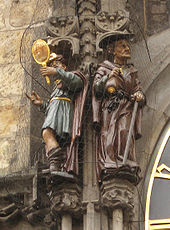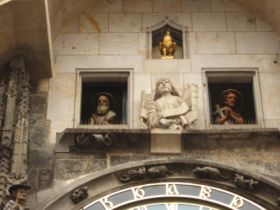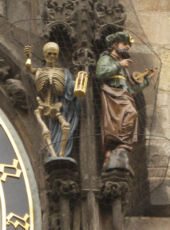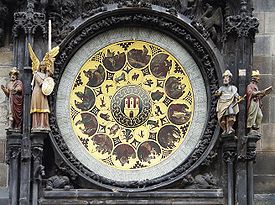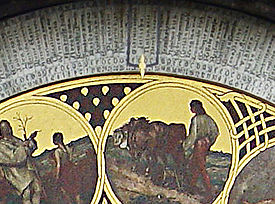- Prague Astronomical Clock
-
The Prague Astronomical Clock or Prague Orloj (Czech: Pražský orloj [praʃskiː orloj]) is a medieval astronomical clock located in Prague, the capital of the Czech Republic, at 50°5′13.23″N 14°25′15.30″E / 50.0870083°N 14.420917°E. The clock was first installed in 1410, making it the third-oldest astronomical clock in the world and the oldest one still working.
Contents
Description
The Orloj is mounted on the southern wall of Old Town City Hall in the Old Town Square. The clock mechanism itself is composed of three main components: the astronomical dial, representing the position of the Sun and Moon in the sky and displaying various astronomical details; "The Walk of the Apostles", a clockwork hourly show of figures of the Apostles and other moving sculptures—notably a figure of Death (represented by a skeleton) striking the time; and a calendar dial with medallions representing the months.
History
The oldest part of the Orloj, the mechanical clock and astronomical dial, dates back to 1410 when it was made by clockmaker Mikuláš of Kadaň and Jan Šindel, the latter a professor of mathematics and astronomy at Charles University.
Later, presumably around 1490, the calendar dial was added and clock facade decorated with gothic sculptures.
In 1552 it was repaired by Jan Taborský, clock-master of Orloj, who also wrote a report on the clock where he mentioned Hanuš as maker of the clock.
The Orloj stopped working many times in the centuries after 1552, and was repaired many times. In the 17th century moving statues were added, and figures of the Apostles were added after major repair in 1865-1866.
The Orloj suffered heavy damage on May 7 and especially May 8, 1945, during the Prague Uprising, when Germans directed incendiary fire from several armored vehicles and an anti-aircraft gun to the south-west side of the Old Town Square in an effort to silence the provocative broadcasting initiated by the National Committee on May 5. The hall and nearby buildings burned along with the wooden sculptures on the Orloj and the calendar dial face made by Josef Mánes. The machinery was repaired, the wooden Apostles restored by Vojtěch Sucharda, and the Orloj started working again in 1948, but only after significant effort.[1]
Formerly, it was believed that the Orloj was constructed in 1490 by clockmaster Jan Růže (also called Hanuš); this is now known to be a historical mistake. A legend, recounted by Alois Jirásek, has it that the clockmaker Hanuš was blinded on the order of the Prague Councillors so that he could not repeat his work; in turn, he broke down the clock, and no one was able to repair it for the next hundred years.
According to local legend the city will suffer if the clock is neglected and its good operation is placed in jeopardy.
600th Anniversary
On October 9, 2010, the Clock's 600th anniversary was celebrated with a light show on the face of the clock tower. Two 2x Christie 18K HD projectors, each with a 1920x1080 resolution, were used to project several animated videos on the clock. The videos showed it being built, torn down, rebuilt, and peeled away to show its internal mechanisms and the famous animated figures, as well as various events in the clock's history. The video interacted with the tower's architecture, such as rain rolling off the arch, and showing the passage of time with moving shadows. The show was developed over the course of four months by the macula, Duber Studio, and Michel Kotek, and was presented by AV Media.[2]
Astronomical dial
The astronomical dial is a form of mechanical astrolabe, a device used in medieval astronomy. Alternatively, one may consider the Orloj to be a primitive planetarium, displaying the current state of the universe.
The astronomical dial has a background that represents the standing Earth and sky, and surrounding it operate four main moving components: the zodiacal ring, an outer rotating ring, an icon representing the Sun, and an icon representing the Moon.
Stationary background
The background represents the Earth and the local view of the sky. The blue circle directly in the center represents the Earth, and the upper blue is the portion of the sky which is above the horizon. The red and black areas indicate portions of the sky below the horizon. During the daytime, the Sun sits over the blue part of the background and at night it sits over the black. During dawn or dusk, the mechanical sun is positioned over the red part of the background.
Written on the eastern (left) part of the horizon is aurora (dawn in Latin) and ortus (rising). On the western (right) part is occasus (sunset), and crepusculum (twilight).
Golden Roman numbers at the outer edge of blue circle are the timescale of a normal 24 hour day and indicate time in local Prague time, or Central European Time. Curved golden lines dividing the blue part of dial into 12 parts are marks for unequal "hours". These hours are defined as 1/12 of the time between sunrise and sunset, and vary as the days grow longer or shorter during the year.
Zodiacal ring
Inside the large black outer circle lies another movable circle marked with the signs of the zodiac which indicates the location of the Sun on the ecliptic. The signs are shown in anticlockwise order. In the photographs accompanying this article, the Sun is currently in Aries, and will be moving anticlockwise into Taurus next.
The displacement of the zodiac circle results from the use of a stereographic projection of the ecliptic plane using the North pole as the basis of the projection. This is commonly seen in astronomical clocks of the period.
The small golden star shows the position of the vernal equinox, and sidereal time can be read on the scale with golden Roman with numerals. Zodiac is on the 366 teeth gear inside the machine. This gear is connect to the sun gear and the moon gear by 24 teeth gear.[clarification needed]
Old Czech time scale
At the outer edge of the clock, golden Schwabacher numerals are set on a black background. These numbers indicate Old Czech Time (or Italian hours), with 24 indicating the time of sunset, which varies during the year from as early as 16:00 in winter to 20:16 in summer. This ring moves back and forth during the year to coincide with the time of sunset.
Sun
The golden Sun moves around the zodiacal circle, thus showing its position on the ecliptic. The sun is attached to an arm with a golden hand, and together they show the time in three different ways:
- The position of the golden hand over the Roman numerals on the background indicates the time in local Prague time.
- The position of the Sun over the curved golden lines indicates the time in unequal hours.
- The position of the golden hand over the outer ring indicates the hours passed after sunset in Old Czech Time.
Additionally, the distance of the Sun from the center of the dial shows the time of sunrise and sunset. Sun and hand of the sun are at the 365 teeth gear inside the machine.
Moon
The movement of the Moon on the ecliptic is shown similarly to that of the Sun, although the speed is much faster (due to the Moon's own orbit around the Earth). The half-silvered sphere of the moon also shows the Lunar phase. Moon is on the 379 teeth gear inside the machine.
Computer Models of Prague Orloj
The movements of the various mechanical parts of the astronomical dial are too slow to appreciate in real time, but become easier to comprehend using a software model of the Orloj, in the form of an animation. One such animation can be found via the home page of "Prague à la carte", or directly by going here. An animated picture with explanations, and a spreadsheet that 'constructs' the clock for each moment in the year and at each place in the world is to see in a Didactic explanation
There are also at least three different applications (apps) available for Windows Phone 7, the iPhone or iPad that are based on the Orloj. They can be found via Zune Marketplace, the App Store or via the first of the two animations linked to in the previous paragraph.
Animated figures
Moving Figures The four figures flanking the clock are set in motion at the hour, these represent four things that were despised at the time of the clock's making. From left to right in the photographs, the first is Vanity, represented by a figure admiring himself in a mirror. Next, a stereotypical Jew holding a bag of gold represents greed or usury. Across the clock stands Death, a skeleton that strikes the time upon the hour. Finally, the Turk tells pleasure and entertainment.
There is also a presentation of statues of the Apostles at the doorways above the clock, with all twelve presented every hour.
Calendar
Calendar Overview and Detail The present-day calendar below the clock was added in 1870.
See also
- Antikythera mechanism
- Armillary sphere
- Astrolabe
- Astronomical clock
- Equation of Time
- Geocentric model
- Horology
- Hour
- Orrery
- Planetarium
- Prague
- Torquetum
References
- ^ Survey of the Reconstruction and Repairs of the Prague Astronomical Clock in the 19th and 20th Century, by Vaclav Heisler; Publisher: National Technical Museum; Praha; undated typescripts from mid-1990s; English translation from a Czech original
- ^ Rose, Alexander (13 October 2010). "Prague Astronomical Clock - 600th Anniversary Show - Long Views: The Long Now Blog". The Long Now Foundation. http://blog.longnow.org/2010/10/13/prague-astronomical-clock-600th-anniversary-show/. Retrieved 24 October 2010.
- Horský, Zdeněk (1988) (in czech). Pražský orloj. Praha: Panorama.
- Malina, Jakub (2005). Prague Horloge [The...] - A Guide to the History and Esoteric Concept of the Astronomical Clock in Prague, Series: Esoteric Prague. Praha: Eminent.
External links
Coordinates: 50°05′13.23″N 14°25′15.30″E / 50.0870083°N 14.420917°E
Categories:- Buildings and structures in Prague
- Astronomical clocks
- Clock towers
- Horology
- Tourism in Prague
- History of astrology
- History of astronomy
Wikimedia Foundation. 2010.







